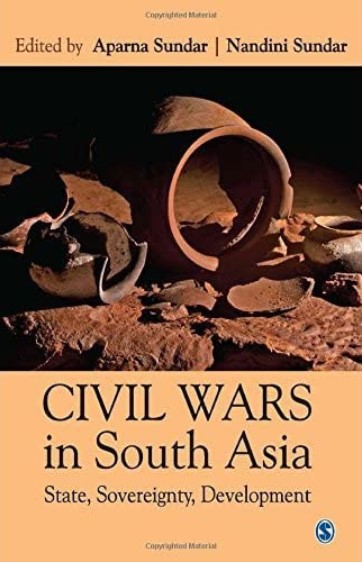
Source:Island
Title: ‘Civil Wars in South Asia – State, Sovereignty, Development ‘
Editors : Aparna Sundar and Nandini Sundar
Publisher: SAGE Publications India Pvt. Ltd. (www.sagepub.in)
Afghanistan’s ongoing agonies and the dramatic ripples caused by them in regional and global inter-state politics should render this collection of valuable research papers titled, ‘Civil Wars in South Asia – State, Sovereignty, Development ‘compulsory reading for both the specialist in international politics and the lay reader with an abiding interest in the subject. Written by erudite researchers in global politics, the papers concerned throw up ample insights of great value into the political, economic and military convulsions that are currently gripping the majority of South and South West Asian states.
The divisive issues in Afghanistan and those that are, and have been, erupting in its neighbouring states, besides calling for in-depth study and analysis, make it essential that the results of such research are made available to polities and publics all over the world. ‘Civil Wars in South Asia…. ‘meets this need in ample measure. What facilitates this process greatly is the fact that most of the papers in this timely book are country specific. Afghanistan, Sri Lanka, India, Myanmar, Pakistan and Nepal are just a few of the states that are brought under the analytical lens of our researchers; many of whom are from the regions concerned and reflect an empathetic and thoroughgoing understanding of the ground realities pertaining to the geographical areas of research.
“The Taliban have emerged among tribal Pashtuns, but they reflect at the same time the erosion of tribal structures. They express the fragmentation of traditional forms of authority and the rise of a new political class that has connections to Dubai or London and legitimizes its upward social mobility in the name of the supranational values of Islam “. Here is a vital spur to further thinking on the true identity of the Taliban which is today at the pinnacle of power in Afghanistan and is being uncritically proclaimed by sections of the world as authentic thinkers and practitioners of Islam.
Contained in the paper titled, “The Transnational Political Economy of Civil War in Afghanistan” by Alessandro Monsutti, such insights are central to understanding the socio-political convulsions assailing Afghanistan and South Asia at present. Policy and decision makers the world over would do well to take cognizance of these disclosures that dive below superficialities.
“Sri Lanka: Military Fiscalism and the Politics of Market Reform at a Time of Civil War” by Rajesh Venugopal offers a range of thought-provoking findings for those researching Sri Lanka’s civil war. The seeming paradox is that Sri Lanka did not falter much in its economic growth throughout its decades of war. This paper provides some keys to unravelling this befuddling puzzle. The market reform process initiated by Sri Lanka in the mid-seventies constitutes one valuable clue to resolving the posers that crowd the reader’s mind in this connection. Reflecting on the “paradox of growth/reform amidst war”, Venugopal says, among other things, “…this does not start off with the casual assumption that growth and reform took place despite war, but instead explores a variety of alternate mechanisms by which the two processes might have related to each other.” The chapter goes on to outline these mechanisms.
‘The Rise of Jihadi Militancy in Pakistan’s Tribal Areas ‘by Haris Gazdar, Yasser Kureshi and Asad Sayeed is yet another paper that provides absorbing reading for those intent on gaining an in-depth understanding of the nation-breaking processes of South Asia. There is a detailed study here of Jihadist militancy obtaining in Pakistan’s border regions with Afghanistan and of its implications for the region’s inter-state politics, including India-Pakistan relations.
There is ample research in this chapter on religion and ethnicity-based militancy which enables the reader to understand better what has gone wrong in the ties of our regional giants. We also begin to understand some of the deeper roots of South Asia’s ethnicity and religion-based separatist violence.
The paper ‘Civil War or Genocide? Britain and the Secession of East Pakistan in 1971 ‘by Dirk Moses, besides other things of substance, helps to draw attention to the pitfalls of viewing the former rebellion in East Pakistan in the lead up to the creation of Bangladesh, in simplistic polarities and categories. Besides the general perception of the separatist uprising in East Pakistan as one based on linguistic self-assertion, the researcher draws attention to the smaller conflicts within the larger conflict, such as the violence visited on religious and ethnic minorities within East Pakistan by the majority community. Our attention is also drawn to the issue of as to when the violence unleashed by a party to a civil war could come to be categorized as being of a genocidal nature.
Besides the above papers there are a number of other country specific research inputs too in ‘Civil Wars in South Asia ‘that help the reader to acquire clarity on state destabilizing political processes in our part of the world. Issues are constantly raised with regard to concepts, such as sovereignty and development, which in the normal course of things are allowed to pass without much critical scrutiny by polities. The introductory chapters to the book are highly instructive in this regard.
Senior Indian academics and editors Aparna Sundar and Nandini Sundar have done remarkably well to bring out a book that is a veritable treasury of knowledge on current South Asian politics.






